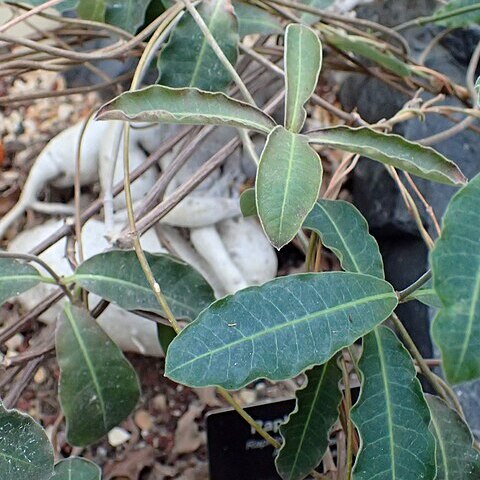Perennial or annual climber with one to few main stems. Tuber up to 0.3 m diameter, spindle-shaped. Aerial stems perennial or may die back at the end of growing season, up to 2 m long, velutinous, interpetiolar ridges often dentate, branching lateral. Leaves spreading, petiolate; petiole 1-15 mm long; blade 30-110 x 5-15 mm, obovate, narrowly obovate or ovate, above velutinous to glabrous, beneath velutinous, margin usually undulate, secondary veins patent to divaricate and 13-18 to a side, apex acute, obtuse or truncate-mucronate, base cuneate to obtuse. Inflorescences sub-terminal, panicle of monochasia, each monochasium 3-5-flowered, velutinous, peduncles 5-20 mm long, pedicels 2-6 mm long; bracts 2-3 mm long, narrowly ovate. Sepals 2-4 x 1-2 mm, ovate, outside velutinous, acute to obtuse, apex acute. Corolla with outside velutinous; tube 2-3 mm long, campanulate; lobes reflexed, 5-7 x 2-3 mm, oblong-ovate to ovate, insides yellow-green with reddish to purple triangular spot at base, apex obtuse to acute. Corona white, coronal feet free, tri-partite; central lobe 4-10 mm long, filiform with dilated base, apex tortuose, papillose; lateral lobes 2-3 mm long, corniculate. Stamens from inner base of coronal feet; filaments ±2 mm long, filiform; anthers ±2 mm long, ovate, white, full length slits, apex acute. Ovaries ±1 mm long; style ±1.5 mm long, terete; style-head ovoid, ±1.5 mm long, obtuse; translators ±2.1 mm long, spoon elliptic. Gynostegium in corolla mouth. Follicles paired, pendulous, seldom solitary, 50-100 x ±10 mm, cylindrical-ovoid, puber-ulous. Seeds 6-7 x 2 mm long, obliquely ovate, coma 10-20 mm long. In South Africa the species flowers from October to February, but flowering specimens were collected even in June. However, in Kenya it flowers around March.
More
Geophytic herb, climbing, 2(-4) m long; tuber fusiform; a few weakly, woody, monopodial stems, spreading, internodes very long. Leaves spreading, ± obovate 110 x 40 mm, dark above, pale below, velutinous, base cuneate, apex truncate to acute and apiculate; veins parallel. Inflorescence axillary, clustered, 3-many-flowered; peduncle 5-10 (-25) mm long. Flowers campanulate, calyx and corolla velutinous outside; tube 2-3 mm long; lobes rotate, reflexed, ovate, 6-7 x 3 mm, yellow-green, maroon marking at base, margins revolute. Corona white, lobes tripartite, middle segment 4-10 mm long, twisting apically, side lobes corniculate, inwardly falcate, 2-3 mm long. Flowering time Oct.-Feb. Follicles paired, narrowly fusiform, 50-100 x 10 mm, patent.

